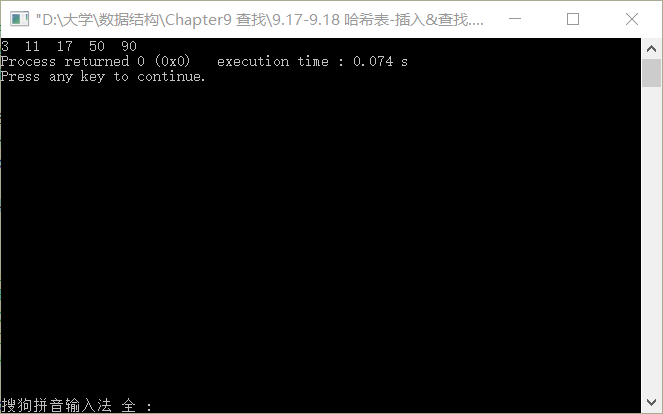#include<stdio.h>
#include<string.h>
#include<stdlib.h>
#define TRUE 1
#define FALSE 0
#define OK 1
#define ERROR 0
#define INFEASIBLE -1
#define OVERFLOW -2
typedef int Status;
typedef int KeyType;
typedef struct
{
KeyType key;
}ElemType;
#define EQ(a,b) ((a) == (b))
#define SUCCESS 1
#define UNSUCCESS 0
#define DUPLICATE -1
#define NULLKEY 0
typedef struct
{
ElemType *elem; //数据元素存储基址,动态分配数组
int count; //当前数据元素个数
int sizeindex; //hashsize[sizeindex]为当前容量
}HashTable; //哈希表
int hashsize[] = {101,211,307,401,503,601,701,809,907,997};
//哈希容量递增表,一个合适的素数序列
int SIZE = 0; //哈希表的容量
/*******************************声明部分****************************************/
Status InitHashTable(HashTable *H);
//initialize a HashTable
unsigned Hash(KeyType key);
//get the hash address
void collision(int *p,int c);
//get next search address p
Status SearchHash(HashTable H,KeyType K,int *p,int *c);
//search an elem.key == K in hash table,if success,use p point to this elem address
//in hashTable,return SUCCESS,else use p point to the insert address,return UNSUCCESS,
//use c to count clash time
Status InsertHash(HashTable *H,ElemType e);
//when SearchHash UNSUCCESS,insert ElemType e into HashTable H,if clash time too much
//Recreate hash table
Status RecreateHashTable(HashTable *H);
//Recreate hash table
/*******************************函数部分****************************************/
Status InitHashTable(HashTable *H)
{
int i;
H->count = 0;
H->sizeindex = 0;
SIZE = hashsize[0];
H->elem = (ElemType *)malloc(SIZE * sizeof(ElemType));
if(!H->elem)
exit(OVERFLOW);
for(i = 0;i < SIZE; i++)
H->elem[i].key = NULLKEY;
return OK;
}
unsigned Hash(KeyType key)
{
return key % SIZE;
}
void collision(int *p,int c) //开放地址法
{
*p = (*p + c) % SIZE;
}
Status SearchHash(HashTable H,KeyType K,int *p,int *c)
{
*p = Hash(K);
while(H.elem[*p].key != NULLKEY && H.elem[*p].key != K){
(*c)++;
if((*c) < SIZE)
collision(p,*c++);
else
break;
}
if(EQ(K,H.elem[*p].key))
return SUCCESS; //查找成功
else
return UNSUCCESS; //查找失败,p返回插入位置
}
Status InsertHash(HashTable *H,ElemType e)
{
int c,p;
c = 0;
if(SearchHash(*H,e.key,&p,&c))
return DUPLICATE;
else if(c < hashsize[H->sizeindex] / 2){
H->elem[p].key = e.key;
++H->count;
return SUCCESS;
}
else{
RecreateHashTable(H);
return UNSUCCESS;
}
}
Status RecreateHashTable(HashTable *H)
{
int i,count;
ElemType *p,*elem;
count = (*H).count;
elem = (ElemType *)malloc(count * sizeof(ElemType));
if(!elem)
exit(OVERFLOW);
for(i = 0;i<SIZE;i++)
if(H->elem[i].key != NULLKEY)
*elem = *((*H).elem + i);
H->count = 0;
H->sizeindex++;
SIZE = hashsize[H->sizeindex];
p = (ElemType *)realloc(H->elem,SIZE * sizeof(ElemType));
if(!p)
exit(OVERFLOW);
H->elem = p;
for(i = 0;i<SIZE;i++){
H->elem[i].key = NULLKEY;
}
for(p = elem;p < elem + count;p++)
InsertHash(H,*p);
}
void TraverseHTable(HashTable H)
{
int i;
for(i = 0;i < SIZE;i++)
if(H.elem[i].key != NULLKEY)
printf("%d ",H.elem[i].key);
}
/*******************************主函数部分**************************************/
int main()
{
HashTable H;
int ct;
InitHashTable(&H);
ElemType a,b,c,d,e;
a.key = 11;
b.key = 3;
c.key = 17;
d.key = 90;
e.key = 50;
InsertHash(&H,a);
InsertHash(&H,b);
InsertHash(&H,c);
InsertHash(&H,d);
InsertHash(&H,e);
TraverseHTable(H);
return 0;
}
评论


 被折叠的 条评论
为什么被折叠?
被折叠的 条评论
为什么被折叠?
查看更多评论

添加红包






























